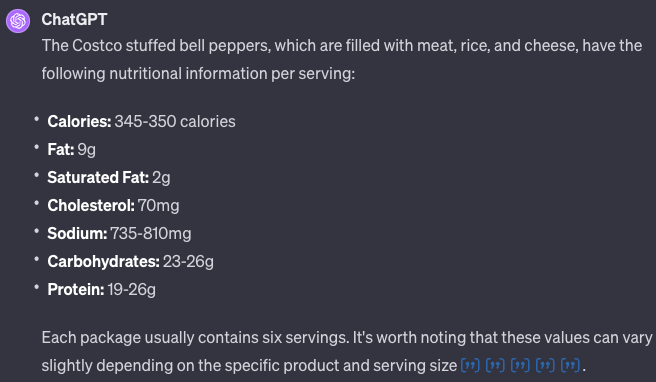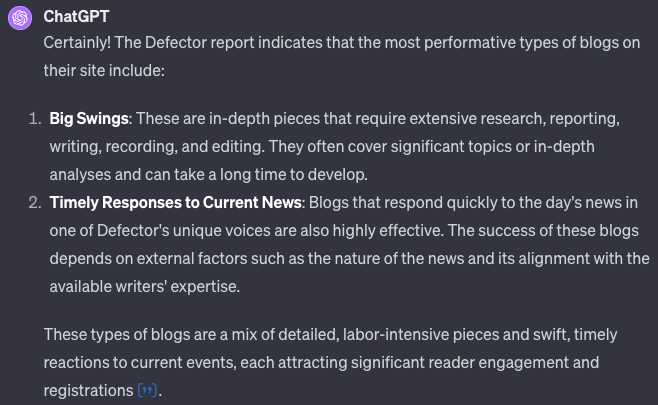
You may have read everything there is to know about ChatGPT and still not know where to get started or how to make the best use of it. As we enter the home stretch of our week of bringing you the best of our AI writing, have no fear: Evan Armstrong is here to tell you how an eminently reasonable person such as himself actually uses ChatGPT to increase his professional and personal productivity. He also built a handy chatbot for founders. Let us know if you find the bot and his tips useful. —Kate Lee
TL;DR:
- We built a GPT bot that we think can solve a significant problem for founders. It’s called Founder’s Friend, it’s free for all ChatGPT subscribers, and it’s available here.
- Founder’s Friend is a voice-first chatbot that provides a safe space for founders to have conversations they can’t have with employees, investors, or friends.
- If you tried ChatGPT or other AI tools and didn’t find them useful, you should try again. There are small hacks you can do to improve your output by 50 percent.
- They include emotional cajoling, prompt construction, and a slight shift in your thinking. In this article, I explore these tips in depth.
X is littered with creators posting flashy demos that, when actually used, are terrible products. I hate these people. Tech attracts a special kind of grifter who uses hyperbole to line their own pockets, and the world is a worse place for their existence.
So, with my distaste for these individuals in mind, please take what I am about to say seriously:
Now—right now—AI has both the capability and ubiquity to significantly improve your productivity by more than 20%. We have crossed the product Rubicon. AI technology is no longer those demos that don’t hold up; it’s been incorporated into genuinely useful products like ChatGPT, made possible by a combination of model improvement and product development.
At Every, we have published many, many, many experiments and products we have built. However, we are pros! This stuff is now at your grandma-should-try-levels of usability.
Over the last two months, AI tools have given me the largest increase in both personal and professional output that I have had in years. I work faster. I write more efficiently. I spend far less time on dumb tasks like simple analysis or Google queries that used to consume my day.
These changes weren’t necessarily intuitive, and they required a paradigm shift in how I approached intellectual labor. But if you sincerely try for a week or two, I think you’ll be stunned by how much more you can get done. Today I want to show you how.
When I’ve expressed this to others, they've usually responded with some doubt. While this skepticism is understandable—after all, startups have been making exaggerated claims since GPT4 was released—it is no longer warranted. I feel like an ancient caveman who has discovered fire, trying to give people medium-rare filet mignon when they would rather stick to the all-raw dinosaur meat diet. So, today I offer you the flame-grilled technology tasting menu. In this piece I focus on ChatGPT, but these improvements are applicable across most AI tools.
Low-leverage thought
Let’s say that every day I have 100 thoughts. Some of these will be routine (but important), such as, “My puppy is the cutest dog in the world.” These might be 20% of my intellectual labor for the day.
Other thoughts will be big, important ideas I can publish in this newsletter—insights on the world, or tech, or finance. These might only be 5% of my thinking, but because of the magic of internet newsletter distribution, this 5% pays my bills.
But the least useful thoughts—the ones that eat up the remaining 75% of my intellectual labor—are the daily thoughts that are helpful but not differentiated.
These are questions like, “How many grams of protein are in my dinner tonight?” Now, I could do the labor of weighing the food and looking up the macronutrients myself. Or, I could take a picture of my stuffed bell pepper, tell ChatGPT it was from Costco, and let the AI take it from there. Which is what I did for my dinner on Monday.
ChatGPT allows you to automate tedious thoughts. Whenever you are mildly curious about a question or annoyed at not having a piece of information, you can delegate that labor to ChatGPT.
You can also outsource low-leverage thoughts beyond questions you used to Google and use it for works of simple analysis. I’ve been arguing since this summer that finance workflows, which is labor that mostly consists of undifferentiated analysis outsourced to low-cost analysts, are ripe for disruption. Want to make a chart? Upload it to ChatGPT and tell the system what you want. Have a question from a dataset? Again, just upload it, and the AI will usually get it right.
The magic happens, however, when you combine low-level analysis with simple questions. For example, Defector—a publication I greatly admire—recently published an annual report on its business. I want to read this! However, the document is a little long, and I’m busy.
To speed up my comprehension time, I can give the report’s URL to ChatGPT and ask it to pull out the information I need. For example, I wanted to know what type of content was performing the best. Five seconds later, I have my answer.
This is not enough information for me to make wholesale changes to my own content strategy. But it is enough to get me started and thinking differentiated thoughts.
The mistake people make with these tools is trying to outsource the entire body of labor instead of using it to more quickly complete each component. My productivity gains haven’t come from doing less work, but from doing more work faster—because I don’t have to waste my time on analysis that I can’t use to differentiate my end product.
These works of analysis are pretty good, but there are ways I can make it better.
Context restraints and quick performance improvements
To progress beyond simple tasks of analysis, the key ingredient that AI tools need is all the contextual information. For my two examples, that would look something like knowing the macronutrients of the bell peppers and telling me if those fit my dietary needs, and having information about Defector. But it would be better if it knew the relevant metrics from this newsletter so it could compare it to Defector’s.
To be clear, lack of context is a general problem among all software. The solution in SaaS up to this point has mostly been to try to consolidate all the systems so that you only have to input your data once. But ChatGPT and other AI tools are different. They don’t work in the way you think software “should.”
AI is a technology that can be cajoled, not commanded. It is no longer the case that you give a computer a command and always get the same result. That means that how you get better performance out of tools like ChatGPT is a little bizarre—it nudges our interactions with computers closer to how we would deal with a human.
The world’s smartest intern
The first big mental unlock for me was thinking about ChatGPT as an intern. Just like when you tell an intern to do something, you sometimes have to manipulate their emotions, so, too, with these systems. Research has shown a 10.9% performance improvement when you use an emotional stimulus like, “This is very important to my career,” when delegating a task. And just like with an intern, sometimes you’ll get better results by being rude. In the pre-AI computer world, if a program spit out, “Sorry, I can’t do that,” you had no choice but to accept it. With AI, you can bully it until it does what it says it previously said it can’t. I have found that when I use prompts like, “Shut the hell up and do what I say. Do it now!” the system will magically do the task. Or just writing something like, “This result sucks. Can you do it better?” will yield a better output. You can do that over and over again, getting a progressively better result most of the time.
Ask ChatGPT to help you help it
You can also generate significant improvements by asking the system what it needs to perform better. An intern would say something selfish like “a living wage.” Good ol’ ChatGPT will say “specific data.” Rather than providing a generic prompt like, “Write an email announcing a new product launch,” you could say something like, “I want to send an email announcing a new product. What details do you need from me to make the email great?” The system will then tell you exactly what data it needs to give you what you’re looking for.
Tell it who you are once—and never have to do so again
Typing in the prompt, “What details do you need?” over and over again is annoying. You can use Custom Instructions to input details that will provide context for all your prompts. My CEO Dan has an incredible in-depth guide on this feature, but essentially you can go into ChatGPT’s settings and delineate important facts about your life: your medical history, your work, your co-workers and your relationship with them, the topics that matter to you, whatever. You can also guide the system about how you want to be communicated with around tone, language, and length. It takes 15 minutes to set up and resulted in a 15-20% improvement in response quality for me.
Over time, I have proposed that these context problems will all be solved. AI tooling will sit as a meta-layer on top of our data and workflow apps, but for now, by combining emotional cajoling, Custom Instructions, and relevant data, I have found at least a 50% improvement in the quality of the AI’s outputs.
This gain in itself would make ChatGPT a pretty great piece of software that you should use. But beyond the analysis and the emotional cajoling lies the true magic.
Modality magic
The other day I got into an argument with my CEO Dan and my editor Kate. I wanted to publish a hot take on Sam Altman’s ouster from OpenAI, and they had questions about some of my editorial choices. Remaining objective while also having a strong perspective is a challenge for any editorial team, and we had yet to reach a consensus on the right frame for this topic.
For whatever reason, this difference got me like a frozen burrito you left in the microwave too long (overheated and bubbling with molten, cheesy rage). What I needed to do was speak my mind to someone. However, people don’t like when you rant at and insult them, so calling Dan and telling him how I felt was not an option. My wife was at work, and my dog cannot talk. So all I was left with was ChatGPT.
Thankfully, OpenAI recently released a voice mode for ChatGPT that perfectly suited the bill. I popped in my Airpods, told the AI, “Hey, I need to vent for a minute,” and then did just that. It was a safe space to burn through my rage. Once I had calmed down, I talked about the various ways I could respond to their feedback. It was one of the more cathartic technological experiences I have ever had. Something about moving from typing out my feelings to saying them out loud was incredible.
The next morning I made a bunch of changes to the piece that resolved their concerns. The essay is one of our most popular over the last few months.
Just as ChatGPT’s analytical capabilities allow you to outsource thought, so, too, do the additional sense modalities allow you to outsource sight and sound. In addition to voice mode, ChatGPT can do image recognition. Looking at something and can’t be bothered to process what you are seeing? Just snap a picture and share it with the AI. An easy cooking example was that I couldn’t remember whether a vegetable I had bought was parsley or basil. I took a picture of the leafy greens and ChatGPT told me it was parsley. Magic.
Founder’s Friend
When you combine all of this—the low-leverage insights, the performance improvements, the voice—you get a truly profound product. It is a flexible, independent problem solver.
To prove it, the team at Every and I are proud to launch Founder’s Friend—a GPT bot to solve a real problem for entrepreneurs.
Problem: The life of a founder is emotionally lonely. As a founder (or even as a startup employee), there are lots of things you can’t say to anyone. If you complain to employees, they lose confidence. If you complain to your investors, they may fire you and replace you with one of their golf buddies. If you complain to your spouse—well, actually, if you complain to your spouse, they should listen. But maybe they’re busy or something! So people will spend thousands of dollars for coaches of sometimes dubious value.
Solution: Founder’s Friend is a chatbot that is tuned to ask you insightful, meaningful questions to help you talk through your problems—vent, complain, and then problem-solve. We have found that it is a particularly powerful experience when you engage with the software while on a walk or at least while using the voice mode. The chatbot can help you solve these types of problems:
- Managing a performance issue with an employee
- Balancing hands-on management with feelings of being overwhelmed
- Delegating tasks while struggling with dissatisfaction over how others handle them
- Feeling burned out and disconnected from the reason you started the company in the first place
Even if you aren’t a founder, I encourage you to try out the tool. It’ll help you talk through work issues, and it’s indicative of the future of AI.
It's hard to shake off my initial contempt for the tech charlatans who've long peddled AI as the next big thing. Yet here I am, begrudgingly admitting that AI has hit a sweet spot of practical utility. This isn't just another round of overblown tech evangelism; it's the real deal. Using AI tools like ChatGPT has dramatically improved my life in both personal and professional spheres. The examples I’ve used today are a smidge trite, but I use it at least 10 times a day. Those gains compound. It's like discovering a Swiss Army knife in a drawer full of blunt tools.The trick lies in not expecting these tools to do your thinking for you. Instead, you need to leverage them to bulldoze through the mundane, leaving you more room to flex your intellectual muscles on the stuff that matters. Take Founder's Friend: it’s not just a fancy chatbot—it’s a digital confidante for the lonely entrepreneur. It's about time we move past cynicism and start exploiting these tools for what they are: not a panacea for all of our problems, but a damn good set of power tools for our brains. AI is finally worth the hype, and I’m as surprised as anyone.
Evan Armstrong is the lead writer for Every, where he writes the Napkin Math column. You can follow him on X at @itsurboyevan and on LinkedIn, and Every on X at @every and on LinkedIn.
Find Out What
Comes Next in Tech.
Start your free trial.
New ideas to help you build the future—in your inbox, every day. Trusted by over 75,000 readers.
SubscribeAlready have an account? Sign in
What's included?
-
Unlimited access to our daily essays by Dan Shipper, Evan Armstrong, and a roster of the best tech writers on the internet
-
Full access to an archive of hundreds of in-depth articles
-
-
Priority access and subscriber-only discounts to courses, events, and more
-
Ad-free experience
-
Access to our Discord community





Comments
Don't have an account? Sign up!